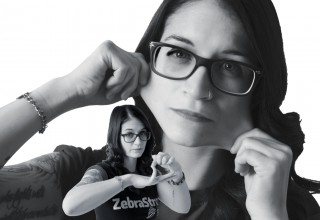
Anonymous donor presents $1 million gift to The Ehlers-Danlos Society to jumpstart groundbreaking genomic research into genetic cause of hypermobile Ehlers-Danlos syndrome (hEDS), a rare, degenerative, and all-too-often painful, disabling connective tissue disorder
Baltimore, MD, February 13, 2018 (Newswire.com) - The Ehlers-Danlos Society has announced the largest single donation in its 33-year history to establish an international research network of leading physicians, geneticists, and other health professionals devoted to finding the underlying genetic markers for hypermobile Ehlers-Danlos syndrome (hEDS) and hypermobility spectrum disorders (HSD).
FROM TRANSFORMATIONAL GIFT TO EHLERS-DANLOS ‘MOONSHOT’
"Although our 29-year-old daughter has remarkable coping ability and good medical support, she is in constant pain. She also has fatigue, nausea, sleep disturbance, and anxiety. Everything she does or plans is affected by Ehlers-Danlos"
Anonymous Donor
The anonymous gift of $1 million dollars, represents the largest individual gift in the history of hypermobile EDS research.
“Because hypermobile Ehlers-Danlos lacks a known genetic cause, this truly has the potential to be a transformational gift,” states Lara Bloom, International Executive Director of The Ehlers-Danlos Society, a global leader in Ehlers-Danlos research, collaboration, and support.
“Through our donor’s extraordinary generosity, we are finally able to launch a virtual ‘moonshot’ in the advancement of our understanding into the most prevalent—and often most vexing—form of the Ehlers-Danlos syndromes,” declares Bloom.
LEVERAGING ADVANCEMENTS IN BIOTECHNOLOGY
“This research endeavor represents the most comprehensive, collaborative effort to date in seeking to understand the underlying causes of hypermobile Ehlers-Danlos syndrome at the level of genes and gene expression. If we can achieve a better understanding of the underlying genetics and the gene expression abnormalities, we may be able to develop diagnostic tests and find more specific treatments for hypermobile EDS—and, potentially, the hypermobility spectrum disorders (HSD),” states the donor, whose adult child is currently battling this too-often debilitating genetic disorder.
“We’ve made great strides in biotechnology over the last two decades and our ability to understand and find treatments for genetic syndromes is at a turning point. It’s time to move forward with detailed research into the underlying issues causing hEDS and HSD so we can know where to target therapy,” declares the generous donor.
BEYOND TESTING: MORE EFFECTIVE TREATMENTS AND HOPES FOR BETTER QUALITY OF LIFE
“We are tremendously grateful for this opportunity to rapidly accelerate our work. For far too long, physicians have struggled to provide the consistent diagnoses necessary to offer comprehensive, effective treatments to everyone affected by EDS and HSD,” states Clair Francomano, M.D., chair of The Ehlers-Danlos Society’s Medical and Scientific board, chair of the International Consortium’s Classical EDS committee, and director of Ehlers-Danlos Society Center for Clinical Care and Research at The Harvey Institute of Human Genetics of the Greater Baltimore Medical Center (GBMC).
“Genetic research is not just a matter of being able to have an objective test, and help with family planning, but it may in fact guide us toward effective treatments in the future. The establishment of the Hypermobile EDS Genetic Research Network provides a framework for next-generation genetic discovery and understanding,” asserts the donor, whose daughter’s struggles with Ehlers-Danlos prompted involvement with The Ehlers-Danlos Society.
FROM CONSTANT PAIN TO A CALLING TO DO MORE
“Although our 29-year-old daughter has remarkable coping ability and good medical support, she is in constant pain. She also has fatigue, nausea, sleep disturbance, and anxiety. Everything she does or plans is affected by Ehlers-Danlos” emphasizes the donor.
“As I’ve learned about hEDS and HSD, I’ve become concerned not only about our own daughter, but also for the many people suffering from these problems around the world. The severity and prevalence of these syndromes is greatly underappreciated—and more research is needed,” continues the donor.
GLOBAL COLLABORATION: THE HYPERMOBILE EDS GENETIC RESEARCH NETWORK
Consisting of leading authorities in fields ranging from human genetics to neurosurgery, The Hypermobile EDS Genetic Research Network will function as the nucleus for research design, data collection, and analysis during the course of the genomic mapping. In addition to Dr. Francomano, the Network currently includes: Peter H. Byers, M.D., of University of Washington; Marco Castori, M.D., Ph.D., IRCCS Casa Sollievo della Sofferenza Hospital in San Giovanni Rotondo, Foggia, Italy; Raymond Dalgleish,Ph.D., University of Leicester; Harry “Hal” Dietz, M.D., Johns Hopkins University School of Medicine; Christina M. Laukaitis, M.D., Ph.D., University of Arizona College of Medicine; Roberto Mendoza, M.D., MSc., The Hospital for Sick Children and University of Toronto; Brendan Lee, M.D., Ph.D., Baylor College of Medicine and Texas Medical Center; Fransiska Malfait, M.D., Ph.D., Center for Medical Genetics, University of Ghent; Brad Tinkle, M.D., Ph.D., Advocate Children’s Hospital and the Advocate Medical Group; and Anthony Vandersteen, M.A., Ph.D., B.M., Maritime Medical Genetics Service at the IWK Health Centre in Halifax, Nova Scotia and Dalhousie University.
CONTACT
Lara Bloom
The Ehlers-Danlos Society
lara.bloom@ehlers-danlos.com
410-670-7577
www.ehlers-danlos.com
Source: The Ehlers-Danlos Society
Share:




